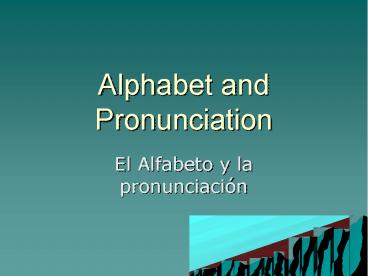Alphabet and Pronunciation - PowerPoint PPT Presentation
Title:
Alphabet and Pronunciation
Description:
Alphabet and Pronunciation El Alfabeto y la pronunciaci n The Spanish Alphabet The Spanish alphabet has 27 letters; 1 more than the English alphabet. – PowerPoint PPT presentation
Number of Views:388
Avg rating:3.0/5.0
Title: Alphabet and Pronunciation
1
Alphabet and Pronunciation
- El Alfabeto y la pronunciación
2
The Spanish Alphabet
- The Spanish alphabet has 27 letters 1 more than
the English alphabet. - The letter combinations of ch, ll, and rr were
once considered separate letters. - For the purpose of this class, we will view them
as separate letters. - The vowels in Spanish have one distinct sound and
are always pronounced the same.
3
10 Rules for Pronunciation
- Rule 1 b and v are both pronounced be but
not as hard as in English. - Rule 2 If c comes before a, o, or u, it
is pronounced like the English k. - Rule 3 If g comes before e or i, it is
pronounced like the letter h. It is pronounced
like the letter g before an a, o, or u. - Rule 4 Never pronounce the letter h.
- Rule 5 The letter j is always pronounced like
h or a spitty g.
4
10 Rules For Pronunciation
- Rule 6 The letter ll is pronounced like the
English y. - Rule 7 The n is pronounced ny.
- Rule 8 The letter q is pronounced k but the
u following the q is not pronounced. - Rule 9 The rr is trilled. The letter r is
trilled at the beginning of a word and when it
come after l or n. - Rule 10 The letter z is always pronounced like
the letter s.
5
Practicing Pronunciation
- The best way to better your pronunciation is to
practice every day. - Find something written in Spanish and read it
along or record yourself to see how you improve. - Practice writing some sentences phonetically to
help with longer, harder words. - Listen to heritage speakers so you will know how
the words are suppose to sound. You can do this
by watching your favorite movie in Spanish, the
Spanish-speaking channels, or simply listening to
the many heritage speakers we have here in school.
6
Phonetics
- Phonetics can be defined as the symbols used to
represent the speech sounds of a language . - We will NOT use real phonetics but a resemblance
to guide us to almost perfect pronunciations. - The letter symbols will not change. The same
symbols will always be used to represent the
corresponding sound.
7
Examples
- El gato es rojo
- /ehl-gah-toh-ehs-rroh-hoh/
- Mi mama y mi padre caminan los domingos.
- /mee-mah-mah-ee-mee-pah-dreh-ka-mee-nahn-lohs-doh-
meen-gohs/ - Juan tiene dieciocho anos.
- /wahn-teeeh-neh-deeeh-see-oh-choh-ahnyos/
- Laura busca el libro que esta debajo de sus
zapatos. - /laoorah-boos-kah-ehl-lee-broh-kay-ehs-tah-deh-bah
-ho-deh-soos-sah-pah-tohs/
8
Stress and Accent
- Where a word is stressed influences how it is
pronounced. - If a word ends in a vowel, n, or s, the natural
stress is on the next to last syllable. - If a word ends in a consonant, other than n or s,
the natural stress falls on the last syllable. - If a word does not follow the two above rules,
the word has a written accent to denote the
stressed syllable. - If the stress falls on the third or fourth to
last syllable, there is always a written accent. - Some words have accent marks to denote meaning
that is different from its counterpart without an
accent (ej. sí yes siif)

